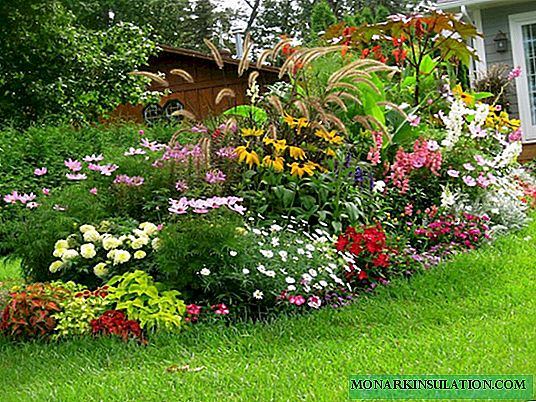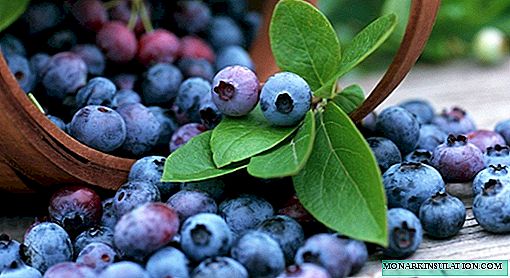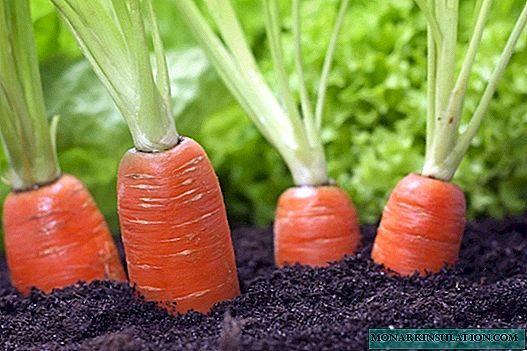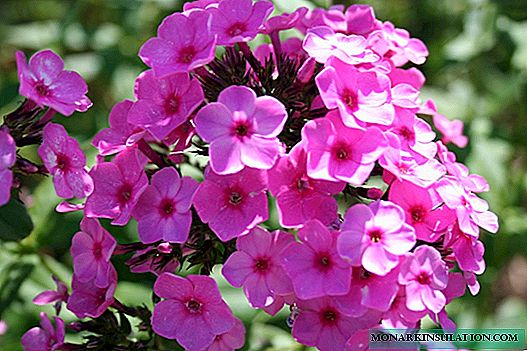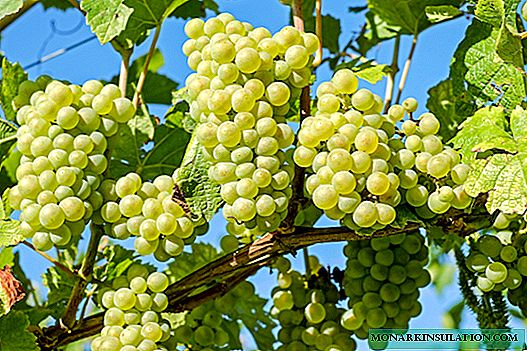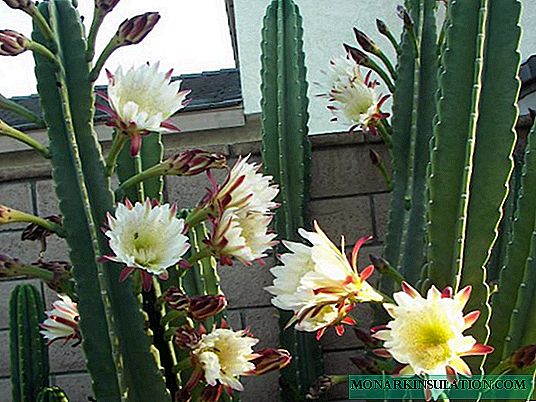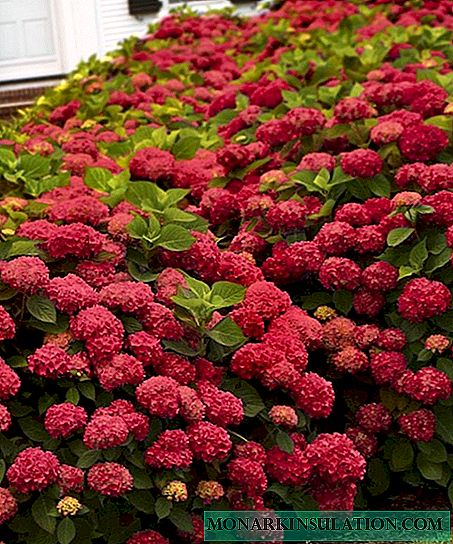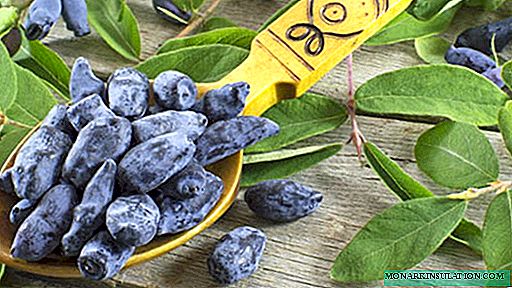
Honeysuckle relatively recently began to be grown as a berry crop. But breeders have already managed to develop many varieties of this plant, which differ significantly from each other both in taste characteristics and in the degree of resistance to adverse conditions.
Edible Honeysuckle Species
To date, more than 100 species of honeysuckle are known. The fruits of almost all of them are inedible, and some are poisonous. So, eating berries of the common honeysuckle (Lonicera xylosteum), which is widespread in the forests of our country, can lead to death.

The fruits of the honeysuckle are very poisonous
In Russia and the CIS countries, only one species of this plant is cultivated with edible berries - blue honeysuckle, or blue (Lonícera caeruléa). It is a deciduous shrub from 1 to 2 m high with blue-black oblong berries, the taste of which resembles blueberries. In the wild, honeysuckle of this species is most often found in East Asia.
Video: Honeysuckle - a guest from the Far East
Blue honeysuckle has many subspecies. Among them:
- honeysuckle Altai. Shrubs with a height of not more than 1 m. Black-blue fruits with a pronounced bitterness ripen throughout the summer. This honeysuckle grows in the forests of Altai, Siberia and the Urals, but can also be found on open mountain slopes;
- Kamchatka honeysuckle. Strongly branched shrub 1.5-2 m high. It begins to bear fruit in the second decade of June. Dark blue berries have a sweet-sour, slightly tart taste;
- Pallas honeysuckle. Shrub up to 1 m high. Its blue-black fruits ripen from late June to early September. Most often they have a bitter taste, but there are also specimens with fairly sweet berries. Pallas honeysuckle usually grows in the moist coniferous forests of North-Eastern Europe and Siberia;
- Turchaninov's honeysuckle. Shrub about 1 m high with a spherical dense crown. Berries are both oblong and rounded. Their taste ranges from sweet to bitter. In the wild, Turchaninov’s honeysuckle is found only on Sakhalin;
- edible honeysuckle. A undersized shrub, the maximum height of which does not exceed 1 m. Dark blue berries with a bluish coating ripen in late June - early July. They are appreciated for their sweet-sour taste and pronounced aroma. Edible honeysuckle is often found in coniferous and deciduous forests of Eastern Siberia and the Far East.
Most subspecies of blue honeysuckle have similar characteristics. Often only professional biologists can distinguish them.
Description and characterization of different varieties of honeysuckle
When creating new varieties, breeders use different subspecies of honeysuckle. This allows you to get plants that meet the various requirements of gardeners. The following characteristics are especially important:
- resistance to adverse environmental conditions;
- the presence of immunity to common diseases and pests;
- fruiting period;
- productivity;
- degree of crumbling;
- size and taste of berries.
Sweet varieties
In the wild, the fruits of blue honeysuckle are often bitter. Breeders have done a great job in order to rid the fruits of cultivated plants from this shortcoming. As a result, many varieties with a rather sweet taste were bred.
Siberian
Sibiryachka was created in 1972 by employees of the Bakcharsky point of northern horticulture (Tomsk region). Its fruits are 1.9-2.4 cm long and weighing up to 1.4 g and contain 8.5% sugars and 1.2% acids. Berries Sibiryachki very juicy and fragrant. They are eaten both fresh and processed.

Sibiryachka variety is valued for sweet and fragrant berries.
The maximum height of the plant is 1.6 m. Fruiting begins in the 2-3rd year of the plant's life. Berry ripening is friendly, usually in mid-June. In the first year of fruiting, 0.5 kg of berries can be collected from the plant. The maximum yield (about 4 kg) of the bush reaches 14-15 years. Active fruiting lasts for 25-30 years.
Sibiryachka is a very winter-hardy variety that can withstand a drop in air temperature to -50 ° C. In addition, the bush easily tolerates drought and is almost not affected by pests and diseases.
Among the disadvantages of the variety can be noted:
- fairly thin peel of the fruit, eliminating the possibility of long transportation;
- crumbling of berries not taken on time, especially strong in conditions of lack of moisture;
- heavily curved branches making harvest difficult.
Nymph
The Nymph variety was obtained at the Pavlovsky station of the Research Institute of Plant Production named after N.I. Vavilova (St. Petersburg). Its main advantage is sweet and fragrant berries with an almost complete absence of a bitter taste. The bluish-blue fruits of the Nymph, whose average weight is 0.8 g, are firmly attached to the branches, so they do not crumble for a long time.

Nymph berries have an elongated spindle shape and a slightly tuberous surface.
Nymph is a vigorous variety. An adult plant can reach a height of 2.5 m. In the midland, the fruits ripen in the last decade of June. Productivity is usually about 2 kg per bush. Under favorable conditions and good care, it can increase to 3-3.5 kg per plant.
The nymph easily tolerates frosty winters: shoots remain viable at -50 ° C, and roots at -40 ° C. Flowers and ovaries withstand a short-term drop in temperature to -8 ° C. This variety is rarely affected by aphids and does not suffer from powdery mildew or tuberculosis.
Many gardeners note the nymph's tendency to thicken the crown. This is easily avoided by timely pruning of branches.
Sylginka
Silginka was bred by employees of the Bakcharsky point of northern horticulture. The bush rarely grows above 1.4 m. The berries have a sweet, slightly sour taste and a delicate aroma. Fruits are dark blue, elongated, with a pointed tip. Their average weight is 1.2-1.4 g. Technical ripeness is reached by the end of June. From one plant you can collect up to 3 kg of berries. The main disadvantage is severe flaking. At the same time, a slight separation of berries from the stalk allows you to quickly and effortlessly collect the entire crop.
Silginka is very resistant to the vagaries of the weather. It easily tolerates winter frosts, summer heat and a long absence of rain. Plants of this variety rarely suffer from diseases and pests.
Almost the most delicious, sweet and large among the varieties in the garden. If you pre-lay the material under the bush - you can easily pick it up by shaking, the berries are easily showered when ripe. Harvest for the 4th year from planting 1.5 kg. I consider myself a good result. A worthy variety for every garden!
Elvir//forum.vinograd.info/showthread.php?t=7456
Video: Honeysuckle Silginka
Cinderella
Variety of selection of the Siberian Research Institute of Horticulture named after M.A. Lisavenko. The berries have a harmonious sour-sweet taste and aroma resembling strawberries.

Variety Cinderella was bred in 1974
The height of the bush is not more than 70 cm. The weight of the berries varies from 0.7 to 1.4 g. Their ripening usually occurs in the second decade of June. In some cases, fruiting lasts for several weeks. Cinderella is characterized by early maturity: the first berries can be harvested already in the 2nd year of plant life. 7-8 years after planting, the bush gives from 2 to 5 kg of fruit.
The honeysuckle of this variety is resistant to low temperature. For all the years of observation in Siberian conditions, not a single case of damage to the bushes from frost or a sharp change in weather was noted. Cinderella is immune to most common diseases.
Large-fruited varieties
Today there are varieties whose berries weigh more than 2 g. Many of them, in addition to their outstanding size, have excellent taste and resistance to adverse conditions.
Bakcharsky giant
One of the largest honeysuckle varieties. The average weight of its fruits is 1.8 g, and the maximum is 2.5 g. The taste of sweet and sour berries. Their flesh is very juicy and tender.

The length of the fruit of the Bakcharsky giant is 4-5 cm
The bush of the Bakcharsky giant is quite powerful. Its height can reach 2 m and a width of 1.5 m. The crown is very thin, which greatly facilitates the collection of berries. This variety tolerates severe winter frosts without much loss and is rarely affected by pests.
The fruits ripen in late June - early July. The average yield is about 2.5 kg of berries per plant, the maximum - 4.5 kg. Ripe berries quite easily showered from the bush.
Bakcharsky Giant - I love! I have not yet seen abundant yields. Huge berries, the skin is thin, not palpable, the taste is sour, it makes no sense to overexpose on the bush. It doesn’t become sweeter, and the berries, when overripe, become completely tender, crush in the hands.
Roza//forum.prihoz.ru/viewtopic.php?f=28&t=3196&start=2520
Leningrad giant
The Leningrad giant is appreciated by gardeners for large and sweet fruits without characteristic bitterness. The weight of berries of this variety can reach 4 g. Among the advantages also include:
- high productivity (average - 3 kg per plant, maximum - 5 kg);
- dense peel of the fruit, which allows the transportation of berries without much loss;
- slight flaking;
- resistance to severe frosts, as well as to diseases and pests.
Among the disadvantages of this variety is the uneven ripening of the fruit, which often stretches from mid-June to the end of July.

The fruits of the Leningrad giant grow in clusters, which greatly simplifies their collection
Early grades
Honeysuckle is the first berry ripening in our areas. Many gardeners seek to accelerate this process and choose the earliest cultivars for planting, the fruits of which ripen in late May-early June.
Blue spindle
Early ripening variety, bred by the staff of the M.A. Lisavenko in 1980. The blue spindle berries ripen in the middle of Russia and Siberia in the first half of June, and in the south in May. Their average weight is about 1 g.
The fruits have a pleasant sweet and sour taste. But with a lack of moisture, noticeable notes of bitterness appear in them. Because of this, the blue spindle berries are often consumed in processed form. Blue spindle is characterized by high early maturity. The first berries appear the next year after planting. The average yield is about 2 kg per plant. The main disadvantage of this variety is a rather strong crumble, due to which up to 15% of ripe fruits are lost.
I did not really like the Blue Spindle variety. Interesting spindle-shaped berries, but not only that, with sourness, they are also bitter.
irinatarbe//otzovik.com/review_2551632.html
Video: comparing Blue Honeysuckle with other varieties
Swan
In central Russia, the Lebedushki berries ripen in early June. They are characterized by a pleasant sweet and sour taste. The average weight of elongated cylindrical fruits is 1.2-1.5 g.
Adult bushes of this variety grow up to 2 m. The yield of one plant under favorable conditions reaches 2.5 kg. Among the advantages of Swans, experts note the dense peel of the fruit, thanks to which they are perfectly stored fresh for about 5 days. In addition, plants tolerate frosts and sharp fluctuations in temperature in the winter.
Blue bird
Fruiting varieties Bluebird usually occurs in mid-June. Small berries (0.7-0.9 g) have a sweet taste and aroma similar to blueberries.

Bluebird ripen in mid-June
Bushes of the Bluebird are vigorous, with a dense spherical crown. Adult plants reach 1.8 m in height. Ripe berries hold tight to the branches and practically do not crumble.
The main disadvantage of this variety is its rather low productivity. From one plant you can collect no more than 2 kg of berries.
Non-crumbling varieties
The berries of most varieties of honeysuckle are easily shed, which is why gardeners who do not collect ripe fruits on time can lose most of the crop. Breeders are constantly working to address this shortcoming.
Amphora
Amphora berries weighing about 1.2 g are firmly attached to the branches, which can make harvesting difficult. Under favorable conditions, about 2 kg of fruit is collected from one bush.
The main advantages of this variety include:
- harmonious sweet and sour taste with a slight bitterness;
- thick and dense peel of the fruit, guaranteeing good transportation;
- friendly ripening of fruits;
- resistance to low temperature.
Amphora is rarely affected by disease. But in some cases, young shoots of a plant may suffer from aphids or honeysuckle ticks. To avoid this, it is necessary to prevent thickening of the crown and monitor the general condition of the bush.
Moraine
Morena (or Little Mermaid) is an early ripe variety. Its large pitcher-shaped fruits ripen in mid-June. The average yield is about 1.5 kg per adult plant. In particularly favorable years, it can reach 2.5 kg. Ripe fruits do not fade or crumble for a long time.

The fruits of the moraine grow to 3-3.5 cm in length and weigh about 1.5 g
Berries of Morena have a sweet and sour dessert taste without bitterness and a pleasant weak aroma. They are often used in the preparation of desserts and preparations for the winter. Morena is listed in the State Register of Varieties as a crop recommended for cultivation in all regions of Russia. It tolerates severe frosts and drought, and also have a high resistance to major diseases and pests.
Of my 10 varieties, Morena seemed to me the most beautiful, large and dessert and without bitterness, in such a dry spring it showed excellent results (there were no rains for May), it wintered well and was all covered with large dessert berries, the branches did not dry out, unlike some other varieties, the berries are very large, but light.
babay133//forum.prihoz.ru/viewtopic.php?t=3196&start=1335
Malvina
Malvina refers to mid-early varieties of honeysuckle. In the Central region of Russia, its fruits usually ripen in mid-June. Ripe berries hold well on the stalk and do not crumble.
The height of the bush Malvina exceeds 1.5 m. Berries elongated pear-shaped with dense skin. Their flesh has a sweet and sour dessert flavor and delicate aroma. The average weight of the fruit is slightly more than 1 g. The yield of this variety is quite high. With good care from one bush, it is possible to collect about 3 kg of berries.
Varieties of modern selection
Breeders do not stop working on creating new varieties of honeysuckle. At the same time, they pay much attention to the consolidation of such qualities as high productivity, large-fruited, lack of bitterness and resistance to adverse environmental conditions.
Giant's daughter
The giant’s daughter was bred in 2009 by specialists of the Bakchark stronghold of northern gardening. To date, this variety is one of the largest. The length of the berries can reach 6 cm, and weight - 2.5-3 g. The ripening of the fruits is quite extended in time and covers the period from late June to mid July.

Berries Daughters of the giant are much larger than the fruits of most varieties of honeysuckle
Also among the advantages of the Daughter of a giant include:
- high productivity (from 3.5 to 5 kg per plant);
- sweet and sour taste;
- the fruits do not crumble;
- dry separation of berries;
- excellent fruit transportability;
- resistance to low temperature and lack of moisture, diseases, pests.
The giant’s daughter is a large, beautiful berry, it keeps up with me later than other varieties, the skin is denser than that of the Bakcharsky giant, the taste is more pleasant.
Roza//forum.prihoz.ru/viewtopic.php?t=3196&start=2520
Sweet
The latest variety of selection of the Kamchatka Research Institute of Agriculture. Sweet tooth fully lives up to its name.Its fruits contain 13.3% sugar and 1.8% acid. The characteristic features of this variety are:
- violet with a strong waxy coating, the color of the fruit is almost regular cylindrical;
- small berry size (maximum weight of about 1.5 g);
- sweet and sour taste of pulp with a pronounced aroma;
- high productivity;
- early ripeness (in the Moscow region, the fruits ripen in mid-June);
- resistance to low temperature and diseases.
The subtleties of choosing a variety for different regions
When choosing a honeysuckle variety, experienced gardeners pay special attention to its adaptability to the climatic conditions of a particular region. Plants that bear fruit well in the North may not tolerate hot weather in more southern areas, and vice versa.
Varieties recommended for cultivation in Siberia
Siberia is the best region for growing honeysuckle. Almost all cultural forms of this plant are perfectly adapted to cold winters and short wet summers. The best results when grown in Siberia show varieties:
- Bakcharsky giant;
- Siberian;
- Cinderella;
- Amphora;
- Moraine.
Honeysuckle for Moscow region and middle lane
In the Moscow region and in other regions of the middle zone, honeysuckle often suffers from repeated autumn flowering, which significantly weakens the plant and prevents a successful wintering and abundant fruiting in the next season. The main reason for this is the warm weather in September and October. Especially resistant to repeated flowering are the varieties of Moscow selection:
- Kingfisher;
- Gzhel early;
- Moscow 23;
- Ramenskaya;
- Roxane
- Amphora.
The champion in yield among them is the Moskovskaya 23 variety, from one bush of which you can collect up to 4 kg of sweet, slightly tart berries. They usually ripen in the first half of June. Fruits must be picked on time, otherwise they will begin to crumble.

Berries of the Moscow 23 variety weigh about 1 g
Gardeners who prefer sweet berries choose Kingfisher. The taste of the fruits of this variety is practically no bitterness. Among other advantages:
- higher than average yield;
- resistance to severe frosts and pests;
- the berries do not crumble.
Varieties for the Leningrad region and the Northwest region
When choosing a variety for planting in the gardens of the Leningrad Region and the Northwest Region, it is necessary to take into account its resistance to freezing after short-term thaws. This quality is possessed by:
- Leningrad giant;
- Swan;
- Amphora;
- Moraine;
- Nymph.
The climatic conditions of this region and the varieties of Moscow breeding are well tolerated.
Varieties cultivated in Belarus
By its climatic conditions, Belarus is very similar to the North-Western region of Russia, therefore, honeysuckle varieties cultivated in the Leningrad Region feel great here. In addition, breeders of this country do not stop working on creating their own varieties. In 2007, they developed the Zinri variety, which is distinguished by an early harvest period (June 3–9).
Other features of the Zinri variety:
- excellent sweet taste with a refreshing aroma;
- fairly high productivity (up to 3 kg per plant);
- resistance to low temperature and fungal diseases;
- low degree of fruit crumbling.

Zinri berries are barrel-shaped
Honeysuckle for Ukraine and southern regions of Russia
Honeysuckle growing in Ukraine and in the south of Russia is very affected by the hot and dry summers. It is almost impossible to harvest a good crop under these conditions. Also, with a lack of water, the fruits of many varieties acquire strong bitterness. A pleasant exception to this rule is Silginka. It quite easily tolerates extreme heat and a prolonged absence of rain.
Experts of the State Commission of Ukraine for Testing and Protection of Plant Varieties recommend two varieties of honeysuckle for planting in the gardens of Poltava, Sumy and Kharkov regions:
- Bogdan. Harvest, not prone to shedding variety. The fruits ripen in the last decade of May and have a dessert sweet taste;
- Violet. The average yield is slightly less than 2 kg per plant. The pulp of fruits is sweet and sour with a delicate aroma. In Ukraine, the berries ripen in early June. A significant disadvantage of this variety is the tendency to shedding, because of which you can lose up to 40% of the crop.
To minimize the adverse effects of a hot climate, experts recommend regularly watering honeysuckle bushes. An excellent result is also obtained by planting this crop near the shores of natural and artificial reservoirs.
Honeysuckle is growing in the south. Suffers from thaws in winter and hot weather in summer. Therefore, the yield, even on 10-year-old bushes, is small.
Nile//club.wcb.ru/index.php?showtopic=1988&st=100
What varieties of honeysuckle should be planted together
All varieties of blue honeysuckle are self-infertile. For pollination of flowers and the appearance of berries, the presence in the reach zone of representatives of another variety is necessary. The more they will be, the richer the harvest. When choosing varieties for the garden, it is necessary to take into account the timing of flowering plants. If they do not coincide, pollination will be impossible and the fruits will not set.
According to most breeders, the taste of berries and the size of the crop depend on the choice of pollinator.
Table: Top Pollinators for Popular Varieties
| Main grade | The best pollinating varieties |
| Siberian |
|
| Nymph |
|
| Sylginka | Bakcharsky giant |
| Cinderella |
|
| Bakcharsky giant |
|
| Leningrad giant |
|
| Blue spindle |
|
| Swan |
|
| Blue bird |
|
| Amphora |
|
| Moraine |
|
| Malvina |
|
| Giant's daughter |
|
| Sweet | Violet |
An important condition for obtaining a good harvest of honeysuckle is a competent choice of variety. In this case, it is necessary to take into account not only one's own preferences, but also the climatic conditions of the region in which the cultivation is planned. Subject to this rule, honeysuckle will delight the gardener with tasty and healthy berries for a long time.


